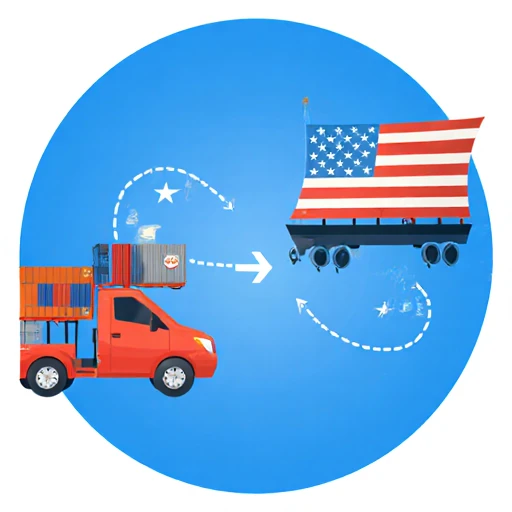International trade between China and the United States remains one of the most active shipping routes in the world. For importers, e-commerce sellers, and Amazon FBA businesses, choosing the right shipping solution is essential to control costs, speed up delivery, and ensure compliance with customs regulations.
Ship from China to US?
Access live freight quotes from global logistics providers.
Get Quotes
🔍 Highlights
- Shipping methods include sea freight (FCL/LCL), air freight, and hybrid solutions.
- Sea freight is cheapest but slowest (30–40 days).
- Air freight is fastest (5–10 days) but most expensive.
- Amazon FBA shipping requires labeling, palletizing, and customs compliance.
- Costs vary: $2–$12 per kg for air freight, $1,200–$5,000 per container for sea freight (Freightos 2025).
- Customs clearance, tariffs, and HS codes are critical to avoid delays.
- Cost optimization involves consolidation (LCL), route selection, and FBA prep services.
- Reliable freight forwarders help with tracking, insurance, and compliance.
🚢 Sea Freight from China to the USA
FCL (Full Container Load): Suitable for large shipments. Cost-effective for full 20ft or 40ft containers.
LCL (Less than Container Load): For smaller volumes; goods are consolidated with others.
Typical transit time (2025): 30–40 Days
Cost (Freightos 2025): $1,200–$5,000 per container
Best for: Bulk cargo, low-value but heavy products, long-term inventory planning.
✈️ Air Freight from China to the USA
Standard air freight: 7–12 Days (door-to-door).
Express courier (FedEx, DHL, UPS): 3–5 Days.
Cost (IATA 2024 data): $4–$12 per kg depending on route & season.
Best for: High-value goods, electronics, urgent shipments, Amazon FBA restock.
🚚 Hybrid Solutions
Hybrid methods balance cost and speed. Cargo is shipped by sea to a hub, then transferred by air or truck for inland delivery.
Transit time: 15–25 Days
Cost: Mid-range between sea & air
Best for: Amazon FBA sellers balancing speed and cost.
🏷️ Amazon FBA Shipping Requirements
- Use Amazon-compliant labeling (FNSKU, carton, and pallet labels).
- Provide packing lists & invoices for customs clearance.
- Ensure palletizing and carton requirements match Amazon’s guidelines.
- Work with a forwarder experienced in Amazon FBA Prep.
📊 Major Port Shipping Routes
1. Shipping from Shanghai / Ningbo to USA
These two ports are typically considered the primary choice for goods from Eastern and Central China. Due to their shorter shipping routes to the U.S. West Coast (e.g., Los Angeles, Long Beach), transit times are also relatively shorter.
| Method |
Transit Time (Days) |
Cost (2025 Estimate) |
| Sea Freight FCL |
15–25 |
$2,000–$4,000/container |
| Sea Freight LCL |
20–30 |
$80–120/m³ |
| Air Freight |
5–10 |
$5–10/kg |
| Sea-Air Hybrid |
12–18 |
30–40% less than air |
| Sea-Truck Hybrid |
12–18 |
20–30% less than air |
2. Shipping from Shenzhen / Guangzhou to USA
These ports are the main export gateways of Southern China, close to Hong Kong, offering more diversified shipping options.
| Method |
Transit Time (Days) |
Cost (2025 Estimate) |
| Sea Freight FCL |
18–28 |
$2,200–$4,500/container |
| Sea Freight LCL |
22–32 |
$90–130/m³ |
| Air Freight |
4–8 |
$6–12/kg |
| Sea-Air Hybrid |
15–20 |
30–40% less than air |
| Sea-Truck Hybrid |
15–20 |
20–30% less than air |
Ready to book?
Access live instant freight quotes
Get Quotes
3. Shipping from Qingdao to USA
As a major port in Northern China, Qingdao's shipping routes primarily serve goods from the northern regions, with an advantage in connecting to the U.S. West Coast.
| Method |
Transit Time (Days) |
Cost (2025 Estimate) |
| Sea Freight FCL |
20–30 |
$2,200–$4,200/container |
| Sea Freight LCL |
25–35 |
$85–125/m³ |
| Air Freight |
5–10 |
$6–12/kg |
| Sea-Air Hybrid |
18–25 |
30–40% less than air |
| Sea-Truck Hybrid |
18–25 |
20–30% less than air |
4. Shipping from Hong Kong to USA
Although Hong Kong's overall shipping costs are usually higher than mainland Chinese ports, it is known for its highly efficient air freight services, making it ideal for high-value, time-sensitive goods.
| Method |
Transit Time (Days) |
Cost (2025 Estimate) |
| Sea Freight FCL |
20–35 |
$2,500–$5,000/container |
| Sea Freight LCL |
25–40 |
$100–150/m³ |
| Air Freight |
3–5 |
$4–12/kg |
| Sea-Air Hybrid |
12–18 |
30–40% less than air |
| Sea-Truck Hybrid |
12–18 |
20–30% less than air |
⚖️ Cost Optimization Strategies
To control shipping costs, businesses can employ several strategies:
- Consolidate shipments (LCL) for small volumes.
- Plan shipping around peak season (avoid Q4 surcharges).
- Choose West Coast vs East Coast ports strategically.
- Use FBA prep centers in China to reduce compliance issues.
- Negotiate long-term contracts with freight forwarders.
- Consider hybrid shipping for balanced costs.
📜 Customs & Regulations (2025 Updates)
Navigating customs is a critical step in the shipping process. Importers should be aware of the following regulations to avoid delays and extra costs:
- Importers must file ISF (Importer Security Filing) before shipping.
- Tariffs vary depending on product HS codes (check USTR updates).
- Customs clearance requires commercial invoice, packing list, and bill of lading.
- Consider freight insurance to protect against damage or loss.
❓ FAQ (International Shipping from China to USA)
Q1: What is the cheapest shipping method from China to the USA?
A1: Sea freight, especially LCL (Less than Container Load), is generally the cheapest method. FCL (Full Container Load) is cost-effective for larger shipments, while air freight is much more expensive.
Q2: How long does sea freight take from China to the USA?
A2: Typical transit time for sea freight is 30–40 days depending on the port of origin and destination.
Q3: What documents are required for customs clearance?
A3: Key documents include a commercial invoice, packing list, bill of lading, and customs declaration form. Some shipments may require certificates of origin or other special permits.
Q4: Can I ship directly to Amazon FBA warehouses?
A4: Yes. You need Amazon-compliant labeling, proper palletizing, and a forwarder experienced with FBA prep to ensure smooth delivery to Amazon warehouses.
Q5: How much does air freight cost per kg from China to the USA?
A5: Air freight costs vary depending on route, weight, and season, typically ranging from $4 to $12 per kg.
Q6: What is the difference between FCL and LCL?
A6: FCL (Full Container Load) is for large shipments that fill a container. LCL (Less than Container Load) allows smaller shipments to share container space with other goods, which can save costs for smaller volumes.
Q7: What is hybrid shipping?
A7: Hybrid shipping combines sea transport to a hub and then air or truck delivery to the final destination. It balances speed and cost compared to pure sea or air freight.
Q8: How can I reduce shipping costs from China to the USA?
A8: Strategies include consolidating shipments, choosing the right port, planning around peak seasons, negotiating contracts with freight forwarders, and using hybrid shipping methods.
Q9: What happens if customs holds my shipment?
A9: Customs may hold shipments for inspection, missing documents, or tariff issues. Work with a licensed customs broker and ensure all documentation is accurate to minimize delays.
Q10: Do I need freight insurance for shipments to the USA?
A10: Yes, freight insurance protects against loss, damage, or theft during transit. It is highly recommended for both sea and air shipments.
Q11: Which ports in the USA are most cost-effective for imports?
A11: Major ports like Los Angeles, Long Beach, New York, Savannah, and Houston are commonly used. West Coast ports are usually cheaper for goods from China due to shorter shipping distance.

 EN
EN
 FR
FR
 ES
ES
 JA
JA
 PT
PT
 RU
RU
 AR
AR





